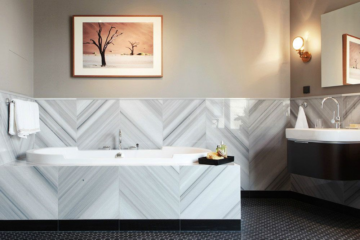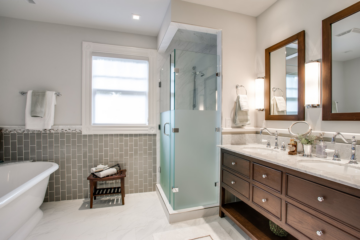Introduction
In the ever-evolving world of interior design, small homes are no longer seen as limiting—they are viewed as opportunities for creativity, efficiency, and style. Among the many design techniques that can transform compact spaces, one stands out for its ability to create instant visual impact: herringbone tiles. Recognizable for their distinctive zig-zag pattern, herringbone tiles have become one of the most sought-after design elements in Australian homes today. They combine heritage charm with contemporary appeal, making them perfect for small spaces where every design choice matters.
But what exactly makes herringbone tiles so effective in compact interiors? To understand their influence, let’s look at their rich history, why they’re back in the spotlight, and how they can be used to elevate the look and feel of even the smallest spaces.
A Brief History of Herringbone
The herringbone pattern dates back thousands of years. The design was first seen in ancient Roman roads, where stone slabs were laid in an interlocking zig-zag arrangement to create more stability against heavy traffic and shifting ground. The pattern’s strength and functionality soon became admired for more than its practicality—it carried a sense of order, movement, and artistry.
Later, in 16th-century Europe, herringbone gained prominence in flooring, especially in French and Italian palaces. The intricate parquet de Versailles floors showcased the sophistication of the pattern, cementing it as a symbol of elegance and timeless taste. By the 18th and 19th centuries, herringbone had become a staple in European architecture, often found in stately homes and upscale estates.
Today, herringbone’s enduring appeal has expanded from wood flooring to tiles, mosaics, and even wall applications, blending tradition with modern innovation.
Why Herringbone is Back in Style
So, why are herringbone tiles suddenly making waves in modern Australian homes? The resurgence can be credited to several key factors:
- Versatility – Herringbone works with almost any style—whether it’s minimalist, coastal, industrial, or Hamptons-inspired. It adapts beautifully to different settings without overwhelming the design.
- Illusion of Space – In compact homes, herringbone patterns naturally draw the eye outward, creating a sense of elongation and openness. This makes rooms appear larger than they actually are.
- Texture and Depth – Flat tiles can sometimes feel uninspired, but herringbone adds texture, dimension, and visual movement, instantly elevating plain walls or floors.
- Trend Cycles – With the growing popularity of retro and classic-inspired interiors, homeowners are embracing heritage designs. Herringbone offers a perfect blend of nostalgic elegance and modern sophistication.
- Global Inspiration – Instagram, Pinterest, and design magazines frequently showcase herringbone patterns in chic apartments from Paris, New York, and London—encouraging homeowners in Australia to adopt the same.
Design Applications of Herringbone Tiles
One of herringbone’s greatest strengths is its adaptability. Here’s how it can be used to make compact spaces shine:

Bathrooms
In small bathrooms, herringbone tiles can turn a simple shower wall into a striking focal point. A vertical herringbone pattern on walls can elongate the room’s height, while a horizontal application across the floor can make the space feel wider. Paired with soft lighting and minimalist fixtures, the result is a spa-like retreat in even the tiniest bathroom.
Kitchens
From splashbacks to flooring, herringbone is a classic choice for kitchens. A subway tile splashback laid in herringbone instantly upgrades a modest kitchenette, giving it a custom-designed look. For floors, darker herringbone tiles provide warmth and contrast, grounding the room while making white cabinets pop.
Living Spaces
In open-plan living areas, herringbone flooring can create a sense of continuity and flow. Its directional layout guides the eye, subtly defining different areas without physical partitions—a clever trick for studio apartments and compact living rooms.
Outdoor Areas
Patios, balconies, and courtyards benefit from herringbone paving as well. Stone or porcelain tiles in this pattern add charm and structure, turning small outdoor nooks into inviting extensions of the home.
Materials and Finishes
The beauty of herringbone lies in its ability to adapt to different materials and finishes. Here are the most popular options:
- Ceramic Tiles – Affordable and versatile, ceramic herringbone tiles are great for splashbacks and feature walls. They come in countless colors, making them a playful choice for statement designs.
- Porcelain Tiles – Known for their durability, porcelain tiles are perfect for high-traffic areas like kitchens and bathrooms. Their resistance to moisture makes them ideal for compact homes where every surface needs to work harder.
- Marble Tiles – For a touch of luxury, marble herringbone tiles bring natural veining and timeless elegance. They suit bathrooms and entryways where a bold statement is desired.
- Wood-Look Tiles – These combine the warmth of timber with the practicality of tiles. Perfect for floors, they replicate traditional parquet without the maintenance concerns of natural wood.
- Glass or Mosaic Tiles – These reflective finishes are excellent for small bathrooms or kitchens, as they bounce light around and make spaces feel brighter and larger.
Pros and Cons of Herringbone Tiles
Pros:
- Timeless and elegant, ensuring your design won’t feel dated.
- Adds visual interest and depth to small spaces.
- Increases perceived value and sophistication of a home.
- Versatile enough to suit modern, classic, and eclectic styles.
Cons:
- Installation can be more expensive due to the precision required.
- Tile waste is often higher compared to standard layouts.
- Poorly executed herringbone can look chaotic rather than stylish.
- In very small patterns, grout lines may dominate the look if not carefully chosen.
Styling Tips for Compact Homes
To maximize the impact of herringbone tiles in small spaces, consider these expert styling tips:
- Choose Light Colors – White, soft grey, or pastel tiles in a herringbone layout make compact areas feel more open and airy.
- Play with Contrast – For a bold look, pair darker herringbone floors with light walls, or use contrasting grout to emphasize the zig-zag design.
- Keep it Simple Elsewhere – Since herringbone is already visually striking, balance it with minimalist furniture and neutral palettes to avoid overwhelming the space.
- Mix and Match – Combine herringbone feature walls with plain tiled areas for subtle sophistication.
- Scale Matters – Larger tiles in herringbone patterns reduce grout lines and create a more streamlined, modern appearance—ideal for compact rooms.
The Future of Herringbone in Interior Design
Looking ahead, herringbone is unlikely to fade from the spotlight. Designers predict its evolution into:
- Bolder Colors – Expect to see navy, emerald green, and terracotta herringbone tiles making statements in Australian homes.
- Mixed Materials – Combining wood, stone, and tiles in a single herringbone layout will bring layered textures into interiors.
- Oversized Patterns – Large-format tiles laid in herringbone patterns are growing in popularity for their clean, modern look.
- Sustainability Focus – With eco-conscious design rising, recycled and sustainable tile options in herringbone layouts will become more mainstream.
Conclusion
Herringbone tiles may be rooted in history, but their modern revival proves their timeless versatility. In compact homes, where design decisions carry extra weight, herringbone is a powerful tool to add depth, movement, and sophistication without overwhelming the space.



0 Comments